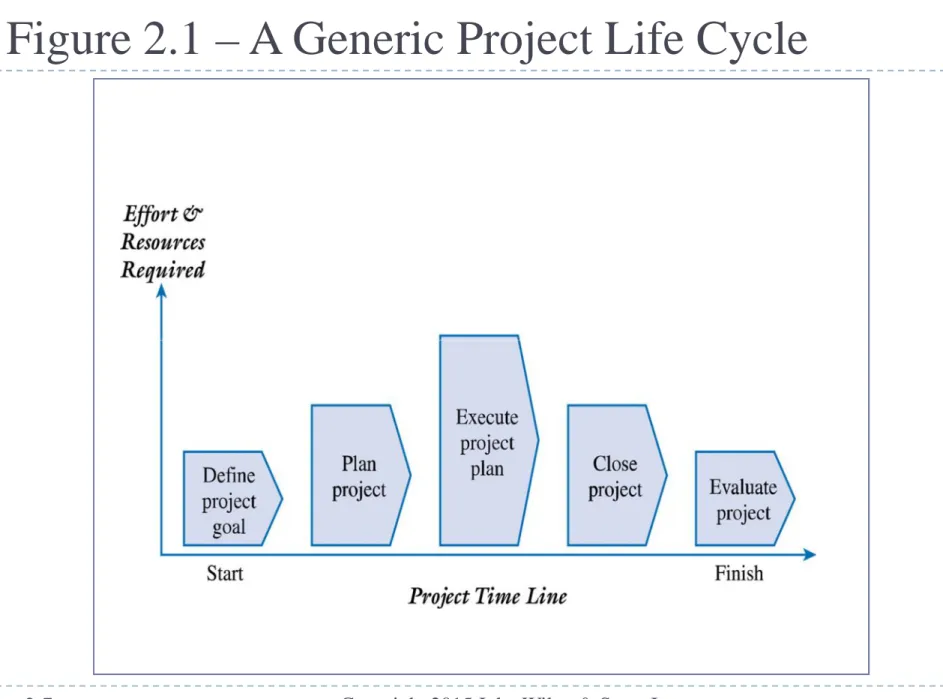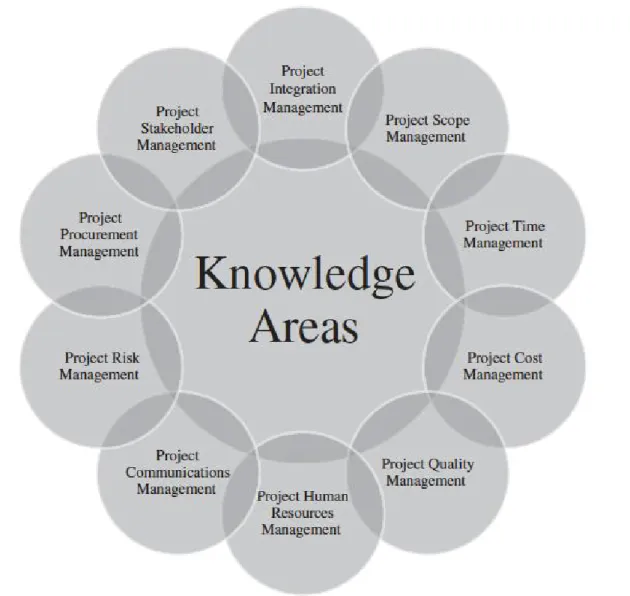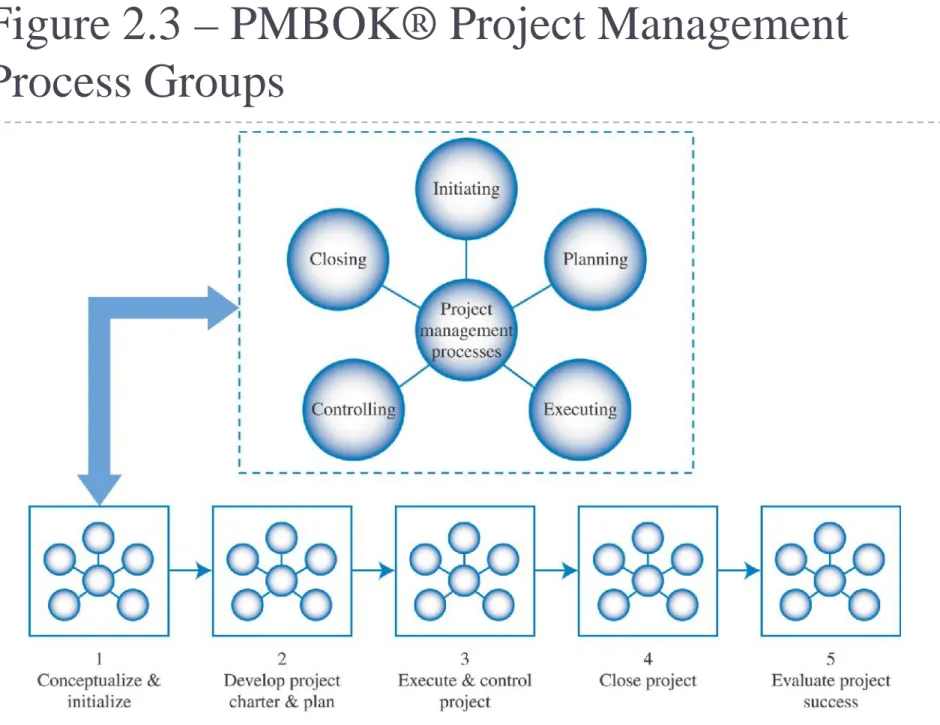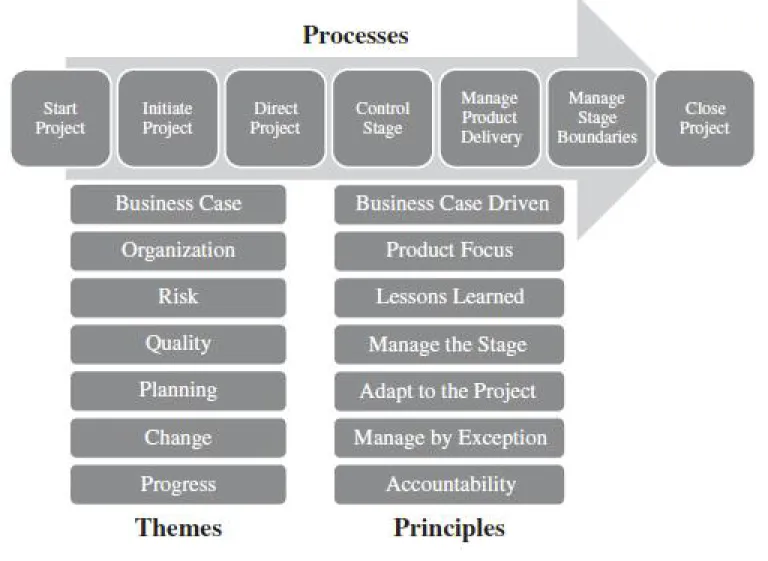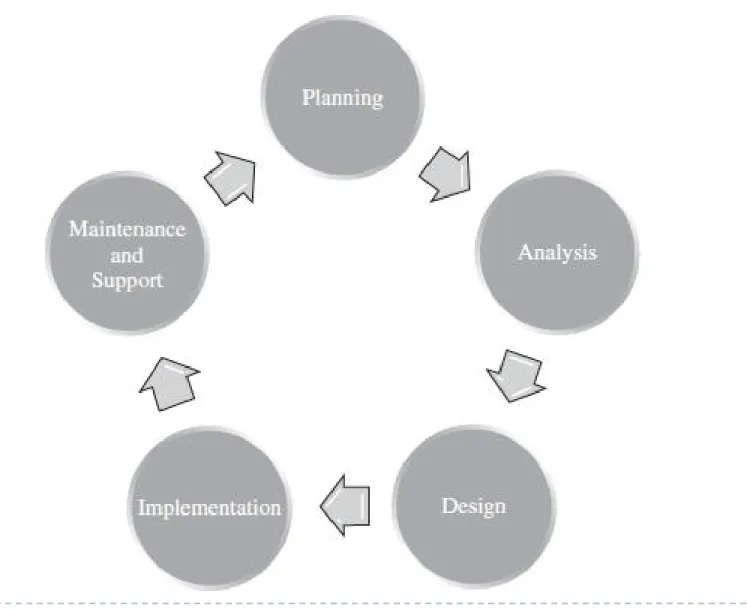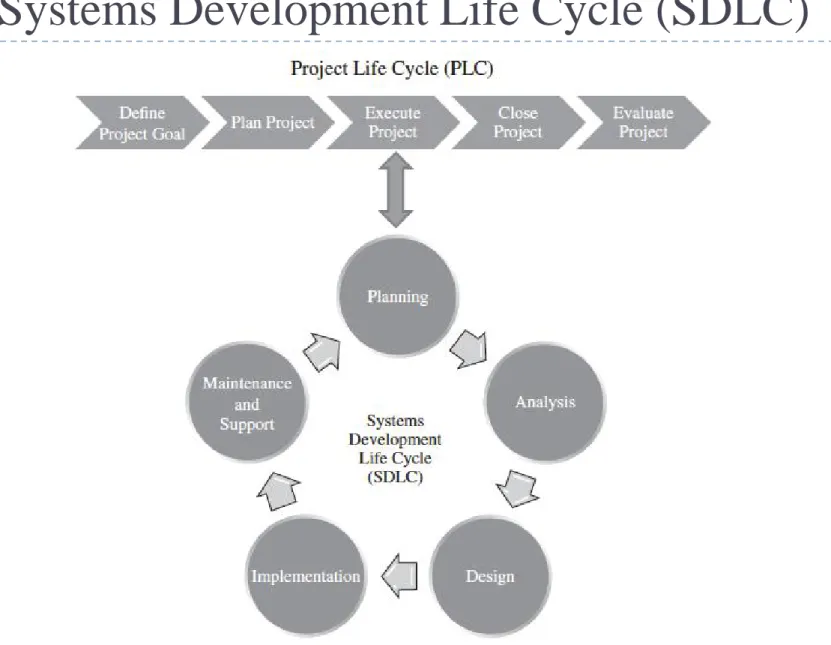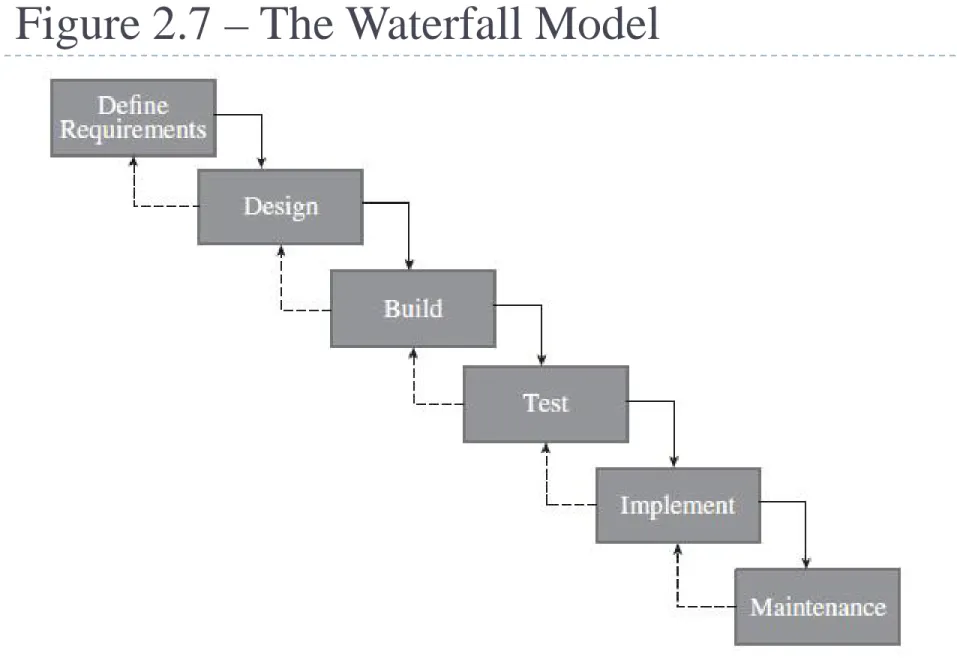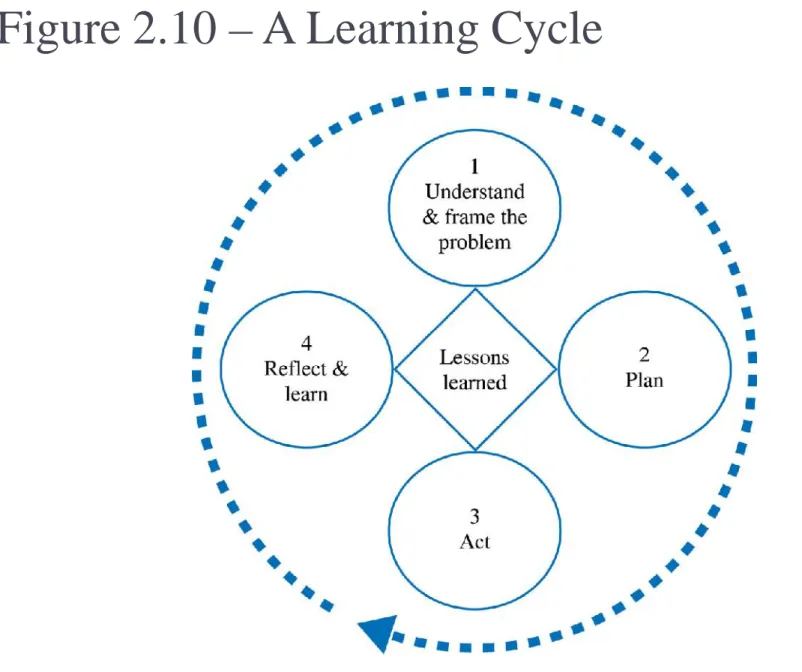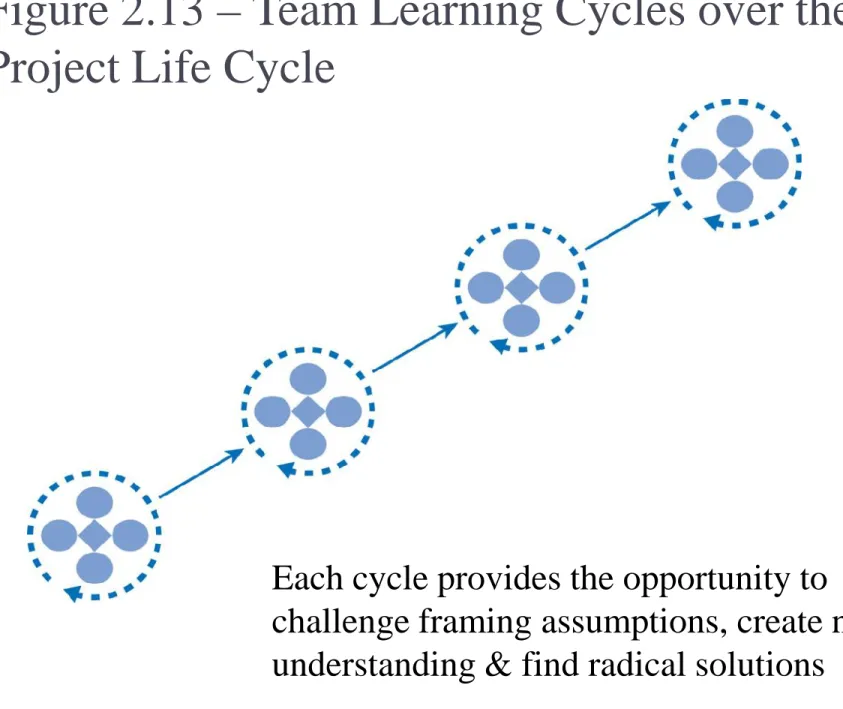Information Technology Project Management – Fifth Edition Information Technology Project Management – Fifth Edition
By Jack T. Marchewka Northern Illinois University
Project Methodologies and Processes
Chapter 2
Learning Objectives
Define what a methodology is and describe the role it serves in IT projects.
Describe the project life cycle (PLC).
Describe the Project Management Body of Knowledge (PMBOK®) and be familiar with its knowledge areas and process groups.
Describe PRINCE2® and be familiar with its core principles, processes, and themes.
Describe the Systems Development Life Cycle ( SDLC).
Describe the Waterfall method for developing the project’s product or system.
Describe the Agile approach for developing the project’s product or system as well as two commonly used approaches called eXtreme Programming (XP) and Scrum..
Describe and apply the concept of Leaning Cycles and lessons learned.
Define what a methodology is and describe the role it serves in IT projects.
Describe the project life cycle (PLC).
Describe the Project Management Body of Knowledge (PMBOK®) and be familiar with its knowledge areas and process groups.
Describe PRINCE2® and be familiar with its core principles, processes, and themes.
Describe the Systems Development Life Cycle ( SDLC).
Describe the Waterfall method for developing the project’s product or system.
Describe the Agile approach for developing the project’s product or system as well as two commonly used approaches called eXtreme Programming (XP) and Scrum..
Describe and apply the concept of Leaning Cycles and lessons learned.
Introduction
Project Methodology
A strategic-level plan for managing and controlling the project
Game plan for implementing project and product lifecycles
Recommends phases, processes, tools, and techniques for supporting an IT project
Must be flexible and include
“best practices
”learned from experiences over time.
Can be
Traditional (e.g., Waterfall)
Project Methodology
A strategic-level plan for managing and controlling the project
Game plan for implementing project and product lifecycles
Recommends phases, processes, tools, and techniques for supporting an IT project
Must be flexible and include
“best practices
”learned from experiences over time.
Can be
Traditional (e.g., Waterfall)
The Project Life Cycle
Collection of logical stages or phases that
maps the life of a project
from its beginning, through its middle, to its end,
to define, build, and deliver the product.
Collection of logical stages or phases that
maps the life of a project
from its beginning, through its middle, to its end,
to define, build, and deliver the product.
Project Phases
Phase Exits, Stage Gates, Kill Points
These are the phase-end review of key deliverables
Allows the organization to evaluate project performance and take immediate action to correct errors or problems
Fast Tracking
Starting the next phase of a project before approval is obtained for the current phase
Can be used to reduce the project schedule
Can be risky and should only be done when the risk is acceptable
Phase Exits, Stage Gates, Kill Points
These are the phase-end review of key deliverables
Allows the organization to evaluate project performance and take immediate action to correct errors or problems
Fast Tracking
Starting the next phase of a project before approval is obtained for the current phase
Can be used to reduce the project schedule
Can be risky and should only be done when the risk is acceptable
Figure 2.1 – A Generic Project Life Cycle
Project Life Cycle – Define and Plan
Define Project Goal
The project goal should be focused on providing business value to the organization
Provides a clear focus and drives the other phases of the project
How will we know if this project is successful given the time, money, and resources invested?
Plan Project
Project Objectives
Resources
Controls
Define Project Goal
The project goal should be focused on providing business value to the organization
Provides a clear focus and drives the other phases of the project
How will we know if this project is successful given the time, money, and resources invested?
Plan Project
Project Objectives
Resources
Controls
Project Life Cycle – Execute, Close, and Evaluate
Execute Project Plan
Manage the project scope, schedule, budget, and people to ensure the project achieves its goal
Progress must be documented and compared to the baseline plan
Project performance must be communicated to all of the stakeholders
Close and Evaluate Project
Ensures that all of the work is completed as planned
Final project report and presentation to the client
Postmortem review
Lessons learned and best practices documented and shared
Execute Project Plan
Manage the project scope, schedule, budget, and people to ensure the project achieves its goal
Progress must be documented and compared to the baseline plan
Project performance must be communicated to all of the stakeholders
Close and Evaluate Project
Ensures that all of the work is completed as planned
Final project report and presentation to the client
Postmortem review
Lessons learned and best practices documented and shared
Figure 2.2 – The PMBOK® Guide – The
10 Project Management Knowledge Areas
PMBOK® Guide – The 10 Project Management Knowledge Areas
1.
Project integration management
2.
Project scope management
3.
Project time management
4.
Project cost management
5.
Project quality management
6.
Project human resource management
7.
Project communications management
8.
Project risk management
9.
Project procurement management
10.
Project stakeholder management
1.
Project integration management
2.
Project scope management
3.
Project time management
4.
Project cost management
5.
Project quality management
6.
Project human resource management
7.
Project communications management
8.
Project risk management
9.
Project procurement management
10.
Project stakeholder management
Figure 2.3 – PMBOK® Project Management
Process Groups
The Five (5) PMBOK® Project Management Process Groups
1.
Initiating
2.
Planning
3.
Executing
4.
Monitoring and Controlling
5.
Closing
1.
Initiating
2.
Planning
3.
Executing
4.
Monitoring and Controlling
5.
Closing
Figure 2-4 – PRINCE2® – The Seven (7)
Processes
The PRINCE2® – Seven (7) Processes
1.
Start Project
2.
Initiate Project
3.
Direct Project
4.
Control Stage
5.
Manage Product Delivery
6.
Manage Stage Boundaries
7.
Close Project
PRINCE2® = Projects IN Controlled Environments
1.
Start Project
2.
Initiate Project
3.
Direct Project
4.
Control Stage
5.
Manage Product Delivery
6.
Manage Stage Boundaries
7.
Close Project
The PRINCE2® – Themes (guidelines to aid project goal achievement)
1.
Business Case
2.
Organization
3.
Risk
4.
Quality
5.
Planning
6.
Change
PRINCE2® = Projects IN Controlled Environments
1.
Business Case
2.
Organization
3.
Risk
4.
Quality
5.
Planning
6.
Change
The PRINCE2® – Principles (Universal guidance for all projects)
1.
Business Case Driven
2.
Product Focus
3.
Lessons Learned
4.
Manage the Stage
5.
Adapt to the Project
6.
Manage by Exception
7.
Accountability
PRINCE2® = Projects IN Controlled Environments
1.
Business Case Driven
2.
Product Focus
3.
Lessons Learned
4.
Manage the Stage
5.
Adapt to the Project
6.
Manage by Exception
7.
Accountability
Figure 2.5 The Systems Development Life Cycle
Systems Development Life Cycle (SDLC)
Planning
Analysis
Design
Implementation
Maintenance and Support
Planning
Analysis
Design
Implementation
Maintenance and Support
Figure 2.6 – The Project Life Cycle (PLC) and
the Systems Development Life Cycle (SDLC)
Implementing the SDLC
Defines all of the subphases and deliverables associated with the Execute and Control
Project Management Life Cycle phase.
Number of Ways to implement the SDLC
Waterfall
Agile
Defines all of the subphases and deliverables associated with the Execute and Control
Project Management Life Cycle phase.
Number of Ways to implement the SDLC
Waterfall
Agile
Figure 2.7 – The Waterfall Model
Agile Systems Development – What is Agile?
Condenses the SDLC into an iteration or sprint
Users and developers work closely together to define and prioritize important (“must have”) features
Emphasize working software to measure progress and rely heavily on face-to-face communication
Umbrella term that includes a number of approaches or methods
Condenses the SDLC into an iteration or sprint
Users and developers work closely together to define and prioritize important (“must have”) features
Emphasize working software to measure progress and rely heavily on face-to-face communication
Umbrella term that includes a number of
approaches or methods
Figure 2.8 – The Agile Manifesto
Agile Systems Development – Four (4) Themes or Categories
Customer
Product
Project Team
Performance
Customer
Product
Project Team
Performance
Agile Methods: Extreme Programming (XP) and Scrum
Methods for project management that are becoming increasingly popular
Characterize many of today’s projects that exemplify speed, uncertainty, changing requirements, and high risks
XP
User requirements first documented as user stories
Document user stories in an object oriented model called a class diagram
Transfers the system in a series of versions called releases
Scrum
Three important roles:
Scrum master – similar to project manager
Product owner– represents the business side, ensures the most important features are included
Development team –responsible for delivering a quality product or system
Product backlog – team prioritizes features that need to be developed/delivered
Methods for project management that are becoming increasingly popular
Characterize many of today’s projects that exemplify speed, uncertainty, changing requirements, and high risks
XP
User requirements first documented as user stories
Document user stories in an object oriented model called a class diagram
Transfers the system in a series of versions called releases
Scrum
Three important roles:
Scrum master – similar to project manager
Product owner– represents the business side, ensures the most important features are included
Development team –responsible for delivering a quality product or system
Product backlog – team prioritizes features that need to be developed/delivered
Figure 2.10 – A Learning Cycle
What we know (Facts)
What we think we know (Assumptions)
What we don’t know (Questions to be Answered)
Company has too much inventory on hand
It may be an efficiency problem
Why are inventory levels so high?
Cost of maintaining current inventory is becoming
prohibitive
Management believes a new information system will improve efficiency and therefore lower inventory levels
What are the current levels of inventory?
Figure 2.11 – An Example of a Team Learning Record
Cost of maintaining current inventory is becoming
prohibitive
Management believes a new information system will improve efficiency and therefore lower inventory levels
What are the current levels of inventory?
Inventory turnover needs to be increased
What is the desired level of inventory?
Who? Does What? By When?
Shedelle and Steve Interview sales team to understand past, current, and future trends for the company’s product.
Tuesday
Myra Provide a detailed count of the current physical inventory on hand.
Thursday
Figure 2.12 – An Example of an Action Plan
Myra Provide a detailed count of the current physical inventory on hand.
Thursday
Corean Research potential inventory management system commercial packages
Thursday
Steve Research average inventory levels for the industry
Wednesday
